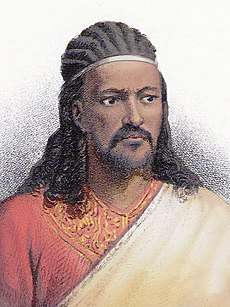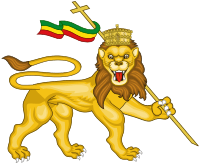Amhara people
Amharas (Amharic: አማራ, Āmara;[11] Ge'ez: አምሐራ, ʾÄməḥära)[12] are a Habesha Ethiosemitic-speaking ethnic group traditionally inhabiting parts of the northwest Highlands of Ethiopia, particularly in the Amhara Region. According to the 2007 national census, Amharas numbered 19,867,817 individuals, comprising 26.9% of Ethiopia's population and they are mostly Orthodox Christians members of Ethiopian Orthodox Church.[1] They are also found within the Ethiopian expatriate community, particularly in North America.[2][13] They speak Amharic, an Afro-Asiatic language of the Semitic branch, a member of the Ethiosemitic group, which serves as the official language of Ethiopia.
አማራ (Amharic) | |
|---|---|
| Regions with significant populations | |
| Ethiopia | 19,867,817[1] |
| United States | 195,260[lower-alpha 1][2] |
| Israel | Unknown[3] |
| Canada | 18,020[lower-alpha 1][4][5][6] |
| United Kingdom | 8,620[lower-alpha 1][7] |
| Australia | 4,515[lower-alpha 1][8] |
| Finland | 1,515[lower-alpha 1][9] |
| Languages | |
| Amharic | |
| Religion | |
| Christianity (Ethiopian Orthodox) • Islam (Sunni) • Judaism | |
| Related ethnic groups | |
| Tigrayans • Tigre • Gurage • Harari • Silte • Zay • Agaw • Saho • Beja • Oromo • Jeberti • Somali • Afar • other Ethiosemitic and Cushitic peoples[10] | |
| |
Some Scholars have classified the Tigrayans and the Amhara as Abyssinians proper under an ultra-neo-conservative definition of Habesha identity postulated by a few Western scholars and Ethiopian ethno-nationalist political parties but not widely accepted by the general public or by most indigenous scholars of the region.[14][15][16][17]
Etymology
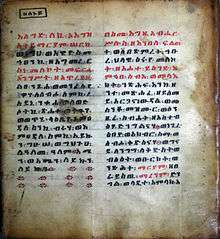
The present name for the Amharic language and its speakers comes from the medieval province of Amhara. The latter enclave was located around Lake Tana at the headwaters of the Blue Nile, and included a slightly larger area than Ethiopia's present-day Amhara Region.
The further derivation of the name is debated. Some trace it to amari ("pleasing; beautiful; gracious") or mehare ("gracious"). The Ethiopian historian Getachew Mekonnen Hasen traces it to an ethnic name related to the Himyarites of ancient Yemen.[18] Still others say that it derives from Ge'ez ዓም (ʿam, "people") and ሓራ (h.ara, "free" or "soldier") in Hebrew עם הר; am עם; hare הר (አም= ህዝብ) ሀር= ተራራማ) (am = people, Hare = mountain) although this has been dismissed by scholar Donald Levine as a folk etymology.[19]
History
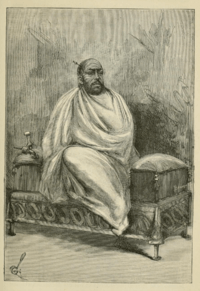
The Amharas have historically inhabited the north, central and western parts of Ethiopia, and are mainly agriculturalists, perhaps constituting the earliest farming group in Ethiopia (along with other groups such as Agews, Gurages, Gafats, Argobas, and Hararis) as they mainly produce and use domesticated grains native to their region such as Teff and Nug.[20] Some suggest their origin to be modern-day Yemen (Sheba and Himyar), the Kingdom of Aksum and relocated to (Amhara) Sayint, now known Wollo (named after an oromo clan that migrated to the area in the 16-17th century), a place that was known as the Amhara region in the past.[21] The Amhara are currently one of the two largest ethnic groups in Ethiopia, along with the Oromo.[20][21] They are sometimes referred to as "Abyssinians" by Western sources.[20][22][23]
The province of "Amhara" was historically located in the modern province of Wollo (Bete Amhara), in the modern sense however the region now known as Amhara in the feudal era was composed of several provinces with greater or less autonomy, which included Gondar, Gojjam, Wollo, Lasta, Shewa, Semien, Angot, and Fetegar.[24] The traditional homeland of the Amharas is the central highland plateau of Ethiopia. For over two thousand years they have inhabited this region. Walled by high mountains and cleaved by great gorges, the ancient realm of Abyssinia has been relatively isolated from the influences of the rest of the world.
Christian Axumite (Axum) presence in the Amhara region dates back to at least the 8th century, with the establishment of the Istifanos monastery in Lake Hayq.[25] Several other sites and monuments indicate similar Axumite presences in area such as the Geta Lion statues, located 10 km south of Kombolcha is thought to date as old the 3rd century or even further to pre-Axumite times.[26] In 1998, pieces of pottery were found around tombs in Atatiya in Southern Wollo in Habru to the south-east of Hayq and to the north-east of Ancharo (Chiqa Beret). The decorations and symbols on the pottery are reliable archaeological evidence that Aksumite civilization had extended to Southern Amhara beyond Angot.[27] Many more ancient sites had probably been plentiful but were likely almost all destroyed by the vengeful reign of Gudit and especially the Muslim invasions led by Imam Ahmad ibn Ibrahim al-Ghazi, where Amhara and Angot were particularly ravaged. The first specific mention of the Amhara dates to the early 12th century in the middle of the Zagwe Dynasty, when the Amhara were recorded of being in conflict with the Werjih in 1129.[28] The Werjih are located to have inhabited the eastern lowlands of Shewa as pastoralists. This indicates that the Amhara not only were existent as a distinct ethnic group, but had already made a presence as far as the southern plateau since at least the 12th century, disproving a common proposition put forward by scholars like Mesfin Woldemariam and Takele Tadesse who suggested that the Amhara did not exist as an ethnic group. Following the end of the ruling Agaw Zagwe dynasty, the Solomonic dynasty governed the Ethiopian Empire for many centuries from the 1270 AD onwards with the ascension of Yekuno Amlak, whose political and support base heiled from Shewa and Amhara. From then up until the deposing of Haile Selassie in 1974, (with the exception of the Tigray Yohannes IV) the Amhara continuously ruled and formed the political core of the Ethiopian Empire, greatly expanding its borders, wealth and international prestige as well as establishing several medieval royal sites and capitals such as Tegulet, Debre Berhan, Barara (located in Entoto, in modern-day Addis Ababa),[29] Gonder, and Magdela, the former three of which were located in Shewa
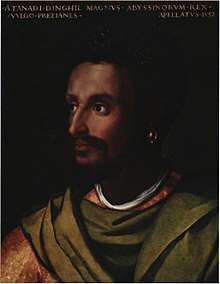
In the early 15th century, the Emperors sought to make diplomatic contact with European kingdoms for the first time since Aksumite times. A letter from King Henry IV of England to the Emperor of Abyssinia survives.[30] In 1428, the Emperor Yeshaq sent two emissaries to Alfonso V of Aragon, who sent return emissaries who failed to complete the return trip.[31] The first continuous relations with a European country began in 1508 with Portugal under Emperor Lebna Dengel, who had just inherited the throne from his father.[32] This proved to be an important development, for when the Empire was subjected to the attacks of the Adal Sultanate General and Imam, Ahmad ibn Ibrahim al-Ghazi (called "Grañ", or "the Left-handed"), Portugal assisted the Ethiopian emperor by sending weapons and four hundred men, who helped his son Gelawdewos defeat Ahmad and re-establish his rule.[33] This Ethiopian–Adal War was also one of the first proxy wars in the region as the Ottoman Empire and Portugal took sides in the conflict.
The Amhara have contributed many rulers over the centuries, including Haile Selassie.[34] Haile Selassie's mother was paternal of Oromo descent and maternally of Gurage heritage, while his father was paternally Oromo and maternally Amhara. He consequently would have been considered Oromo in a patrilineal society, and would have been viewed as Gurage in a matrilineal one. However, in the main, Haile Selassie was regarded as Amhara, his paternal grandmother's royal lineage, through which he was able to ascend to the Imperial throne.[35]
Social stratification
Within traditional Amharic society and that of other local Afro-Asiatic-speaking populations, there were four basic strata. According to the Ethiopianist Donald Levine, these consisted of high-ranking clans, low-ranking clans, caste groups (artisans), and slaves.[36][37] Slaves were at the bottom of the hierarchy, and were primarily drawn from the pagan Nilotic Shanqella groups. Also known as the barya (meaning "slave" in Amharic), they were captured during slave raids in Ethiopia's southern hinterland. War captives were another source of slaves, but the perception, treatment and duties of these prisoners was markedly different.[38] According to Levine, the widespread slavery in Greater Ethiopia formally ended in the 1930s, but former slaves, their offspring, and de facto slaves continued to hold similar positions in the social hierarchy.[39]
The separate, Amhara caste system, ranked higher than slaves, consisted of: (1) endogamy, (2) hierarchical status, (3) restraints on commensality, (4) pollution concepts, (5) each caste has had a traditional occupation, and (6) inherited caste membership.[36][40] Scholars accept that there has been a rigid, endogamous and occupationally closed social stratification among Amhara and other Afro-Asiatic-speaking Ethiopian ethnic groups. However, some label it as an economically closed, endogamous class system or as occupational minorities,[41][42] whereas others such as the historian David Todd assert that this system can be unequivocally labelled as caste-based.[43][44][45]
Language
The Amhara speak Amharic (also known as Amarigna or Amarinya) as a mother tongue. It is spoken by 29.3% of the Ethiopian population.[46] It belongs to the Semitic branch of the Afro-Asiatic family.[47]
According to Donald Levine, the Afro-Asiatic (Hamito-Semitic) language family likely arose in either the eastern Sahara or southwestern Ethiopia. Early Afro-Asiatic populations speaking proto-Semitic, proto-Cushitic and proto-Omotic languages would have diverged by the fourth or fifth millennium BC. Shortly afterwards, the proto-Cushitic and proto-Omotic groups would have settled in the Ethiopian highlands, with the proto-Semitic speakers crossing the Sinai Peninsula into Asia Minor. A later return movement of peoples from South Arabia would have introduced the Semitic languages to Ethiopia.[48] Based on archaeological evidence, the presence of Semitic speakers in the territory date to sometime before 500 BC.[21] Linguistic analysis suggests the presence of Semitic languages in Ethiopia as early as 2000 BC. Levine indicates that by the end of that millennium, the core inhabitants of Greater Ethiopia would have consisted of swarthy Caucasoid ("Afro-Mediterranean") agropastoralists speaking Afro-Asiatic languages of the Semitic, Cushitic and Omotic branches.[48]
According to Robert Fay, the ancient Semitic speakers from Yemen were Himyarites and they settled in the Aksum area in northern Ethiopia. There, they intermarried with native speakers of Agaw and other Cushitic languages, and gradually spread southwards into the modern Amhara homeland. Their descendants, the early predecessors of the Amhara, spoke Ge'ez, the official language of the Ethiopian Orthodox Tewahedo Church.[49] On the other hand, Ethiopian scholars specializing in Ethiopian Studies such as Messay Kebede and Daniel E. Alemu generally disagree with this theory arguing that the migration was one of reciprocal exchange, if it even occurred at all, and that the Amharas and other Ethiosemistic-speaking ethnic groups should not be characterized as foreign invaders.
Kebede states the following;[50][51]
"This is not to say that events associated with conquest, conflict and resistance did not occur. No doubt, they must have been frequent. But the crucial difference lies in the propensity to present them, not as the process by which an alien majority imposed its rule but as part of an ongoing struggle of native forces competing for supremacy in the region. The elimination of the alien ruler indigenize Ethiopian history in terms of local actors."
Amharic is the working language of the federal authorities of Ethiopia government. It was for some time also the language of primary school instruction, but has been replaced in many areas by regional languages such as Oromifa and Tigrinya. Nevertheless, Amharic is still widely used as the working language of Amhara Region, Benishangul-Gumuz Region, Gambela Region and Southern Nations, Nationalities, and Peoples' Region.[52] The Amharic language is transcribed using the Ethiopic or Ge'ez script (Fidäl), an abugida. The Amharic language is the official language of Ethiopia.
Most of the Ethiopian Jewish communities in Ethiopia and Israel speak Amharic.[3] Many in the popular Rastafari movement learn Amharic as a second language, as they consider it to be a sacred language.[53]
Religion
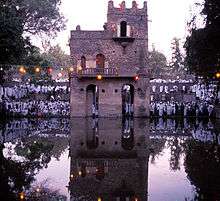
The predominant religion of the Amhara for centuries has been Christianity, with the Ethiopian Orthodox Tewahedo Church playing a central role in the culture of the country. According to the 2007 census, 82.5% of the population of the Amhara Region were Ethiopian Orthodox; 17.2% were Muslim, and 0.2% were Protestant and 0.5 beta Israel .[54] The Ethiopian Orthodox Church maintains close links with the Coptic Orthodox Church of Alexandria. Easter and Epiphany are the most important celebrations, marked with services, feasting and dancing. There are also many feast days throughout the year, when only vegetables or fish may be eaten.
Marriages are often arranged, with men marrying in their late teens or early twenties.[55] Traditionally, girls were married as young as 14, but in the 20th century, the minimum age was raised to 18, and this was enforced by the Imperial government. After a church wedding, divorce is frowned upon.[55] Each family hosts a separate wedding feast after the wedding.
Upon childbirth, a priest will visit the family to bless the infant. The mother and child remain in the house for 40 days after birth for physical and emotional strength. The infant will be taken to the church for baptism at 40 days (for boys) or 80 days (for girls).[56]
Culture
Art
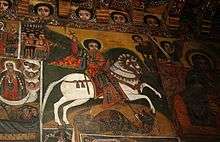
Amhara art is typified by religious paintings. One of the notable features of these is the large eyes of the subjects, who are usually biblical figures. It is usually oil on canvas or hide, some surviving from the Middle Ages. The Amhara art includes weaved products embellished with embroidery. Works in gold and silver exist in the form of filigree jewelry and religious emblems.
Agriculture
About 90% of the Amhara are rural and make their living through farming, mostly in the Ethiopian highlands. Barley, corn, millet, wheat, sorghum, and teff, along with beans, peppers, chickpeas, and other vegetables, are the most important crops. In the highlands one crop per year is normal, while in the lowlands two are possible. Cattle, sheep, and goats are also raised.
Kinship and marriage
The Amhara culture recognizes kinship, but unlike other ethnic groups in the Horn of Africa region, it has a relatively lesser role. Household relationships are primary, and the major economic, political and cultural functions are not based on kin relationships among the Amharas. Rather abilities of the individual matter. For example, states Donald Levine, the influence of clergy among the Amhara has been based on "ritual purity, doctrinal knowledge, ability to perform miracles and capacity to provide moral guidance".[57] The social relationships in the Amhara culture are predominantly based on hierarchical patterns and individualistic associations.[58]
Family and kin relatives are often involved in arranging semanya (eighty bond marriage, also called kal kidan), which has been most common and allows divorce.[59] Other forms of marriage include qurban, which is solemnized in church, where divorce is forbidden, and usually observed among the orthodox priests.[60][60][61] Patrilineal descent is the norm.[60] While the wife had no inheritance rights, in case a child was conceived during the temporary damoz marriage, the child could make a claim a part of the father's property.[61][62]
Cuisine
The Amharas' cuisine consists of various vegetable or meat side dishes and entrées, usually a wat, or thick stew, served atop injera, a large sourdough flatbread made of teff flour. Kitfo being originated from Gurage is one of the widely accepted and favorite food in Amhara. They do not eat pork or shellfish of any kind for religious reasons. It is also a common cultural practice of Amhara to eat from the same dish in the center of the table with a group of people.
Notable Amharas
- Andualem Aragie, Vice President and Press Secretary for the Ethiopian-based Unity for Democracy and Justice
- Aster Aweke, Ethiopian singer
- Berhaneyesus Demerew Souraphiel, Ethiopian Catholic cardinal, Head of the Ethiopian Catholic Church.
- Baalu Girma, Ethiopian journalist and Author
- Baeda Maryam I,[63] Emperor of the Ethiopian Empire
- Bakaffa,[64] Emperor of the Ethiopian Empire
- Belay Zeleke,[65] patriot
- Abuna Basilios, First Patriarch of the Ethiopian Orthodox Tewahido Church
- Abuna Theophilos, Second Patriarch of the Ethiopian Orthodox Tewahido Church
- Abune Petros,[63] patriot
- Afewerk Tekle, Honorable Laureate Maitre Artiste
- Amda Seyon I,[63] Emperor of the Ethiopian Empire
- Mohammed Hussein Al Amoudi, Ethiopian businessman
- Asrat Woldeyes,[66] Surgeon
- Aklilu Habte-Wold, Prime Minister
- Aba Gorgorios,[67] Catholic priest
- Dawit I,[63] Emperor of the Ethiopian Empire
- Dawit II,[64][68] Emperor of the Ethiopian Empire
- Dawit III,[69] Emperor of the Ethiopian Empire
- Ejigayehu Shibabaw, better known as Gigi, Ethiopian singer
- Eleni Gebre-Medhin, prominent female Ethiopian economist.
- Eskender,[70] Emperor of the Ethiopian Empire
- Fasilides,[63] Emperor of the Ethiopian Empire
- Gebre Hanna, dabtara renowned in Amharic oral tradition
- Gelawdewos,[63] Emperor of the Ethiopian Empire
- Gelila Bekele,[71][72] International model
- Getatchew Haile,[73] philologist
- Getatchew Mekurya, Legendary Ethiopian Jazz Saxophonist
- Haddis Alemayehu, Foreign Minister and Novelist
- Haile Gerima, Award-winning writer, producer & director.
- Haile Gebrselassie, renowned world Athlete
- Haile Selassie,[63] Emperor of the Ethiopian Empire
- Heruy Wolde Selassie, Foreign Minister
- Iyasu I,[63] Emperor of the Ethiopian Empire
- Iyasu II,[64] Emperor of the Ethiopian Empire
- Liya Kebede, International supermodel
- Menas of Ethiopia,[63] Emperor of the Ethiopian Empire
- Menelik II,[74][63] Emperor of the Ethiopian Empire
- Makonnen Wolde Mikael, Military officer, diplomat, court official
- Menen Asfaw, Empress of Ethiopia, reign between 2 November 1930 – 15 February 1962
- Mesfin Woldemariam, author, Sakharov prize winning human rights activist and politician.
- Muluken Melesse, Music Artist
- Na'od,[64] Emperor of the Ethiopian Empire
- Newaya Krestos,[64][75] Emperor of the Ethiopian Empire
- Newaya Maryam,[76] Emperor of the Ethiopian Empire
- Sarsa Dengel,[77] Emperor of the Ethiopian Empire
- Seifu Mikael, diplomat, governor
- Susenyos I, Emperor of the Ethiopian Empire[78]
- Teddy Afro, Ethiopian singer
- Tewodros II,[79] Emperor of the Ethiopian Empire
- The Weeknd, Ethiopian-Canadian R&B artist
- Wolde Giorgis Wolde Yohannes, Minister of the pen
- Workneh Eshete, surgeon and diplomat
- Yaqob,[80] Emperor of the Ethiopian Empire
- Yekuno Amlak,[81] founder of the Solomonic Dynasty
- Yetnebersh Nigussie, is a renowned lawyer and disability rights activist from Amhara Saint, Bete-Amhara (Wello now), Amhara regional state, Ethiopia.
- Yeshaq I,[82] Emperor of the Ethiopian Empire
- Zara Yaqob,[83] Emperor of the Ethiopian Empire
See also
- Cushitic peoples
- Habesha people
- History of Ethiopia
Notes
References
- Central Statistical Agency, Ethiopia. "Table 2.2 Percentage Distribution of Major Ethnic Groups: 2007" (PDF). Summary and Statistical Report of the 2007 Population and Housing Census Results. United Nations Population Fund. p. 16. Archived from the original (PDF) on 25 March 2009. Retrieved 29 October 2014.
- United States Census Bureau 2009–2013, Detailed Languages Spoken at Home and Ability to Speak English for the Population 5 Years and Over: 2009–2013, USCB, 30 November 2016, <https://www.census.gov/data/tables/2013/demo/2009-2013-lang-tables.html>.
- Teferra, Anbessa (2018). "Hebraized Amharic in Israel". In Hary, Benjamin; Bunin Benor, Sarah (eds.). Languages in Jewish Communities, Past and Present. Berlin: Walter De Gruyter. pp. 489–519. ISBN 9781501512988.
- Statistics Canada, 2011 Census of Population, Statistics Canada Catalogue no. 98-314-XCB2011032
- Anon, 2016. 2011 Census of Canada: Topic-based tabulations | Detailed Mother Tongue (232), Knowledge of Official Languages (5), Age Groups (17A) and Sex (3) for the Population Excluding Institutional Residents of Canada and Forward Sortation Areas, 2011 Census. [online] Www12.statcan.gc.ca. Available at: <http://www12.statcan.gc.ca/census-recensement/2011/dp-pd/tbt-tt/Rp-eng.cfm?LANG=E&APATH=3&DETAIL=0&DIM=0&FL=A&FREE=0&GC=0&GID=0&GK=0&GRP=1&PID=103001&PRID=10&PTYPE=101955&S=0&SHOWALL=0&SUB=0&Temporal=2011&THEME=90&VID=0&VNAMEE=&VNAMEF=> [Accessed 2 December 2016].
- Immigrant languages in Canada. 2016. Immigrant languages in Canada. [ONLINE] Available at: https://www12.statcan.gc.ca/census-recensement/2011/as-sa/98-314-x/98-314-x2011003_2-eng.cfm. [Accessed 13 December 2016].
- pp, 25 (2015) United Kingdom. Available at: https://www.ethnologue.com/country/GB (Accessed: 30 November 2016).
- Australian Bureau of Statistics 2014, The People of Australia Statistics from the 2011 Census, Cat. no. 2901.0, ABS, 30 November 2016, <https://www.border.gov.au/ReportsandPublications/Documents/research/people-australia-2013-statistics.pdf Archived 17 April 2017 at the Wayback Machine>.
- "Archived copy". Archived from the original on 26 June 2018. Retrieved 24 January 2019.CS1 maint: archived copy as title (link)
- Joireman, Sandra F. (1997). Institutional Change in the Horn of Africa: The Allocation of Property Rights and Implications for Development. Universal-Publishers. p. 1. ISBN 1581120001.
The Horn of Africa encompasses the countries of Ethiopia, Eritrea, Djibouti and Somalia. These countries share similar peoples, languages, and geographical endowments.
- Following the BGN/PCGN romanization employed for Amharic geographic names in British and American English.
- Zegeye, Abebe (15 October 1994). Ethiopia in Change. British Academic Press. p. 13. ISBN 9781850436447.
- Olson, James (1996). The Peoples of Africa. Greenwood Publishing Group. p. 27. ISBN 9780313279188.
- Levine, Donald (May 2000). Greater Ethiopia: The Evolution of a Multiethnic Society. University of Chicago Press. p. 18. ISBN 9780226475615. Retrieved 28 December 2016.
- Marvin Lionel Bender (1976). Language in Ethiopia. Oxford University Press. p. 26. ISBN 978-0-19-436102-6.
- Paul B. Henze (1985). Rebels and Separatists in Ethiopia: Regional Resistance to a Marxist Regime. Rand. p. 8. ISBN 978-0-8330-0696-7.
- Goitom, M. (2017). "Unconventional canadians": Second-generation "Habesha" youth and belonging in toronto, canada. Global Social Welfare, 4(4), 179–190. doi: ...
- Getachew Mekonnen Hasen. Wollo, Yager Dibab, p. 11. Nigd Matemiya Bet (Addis Ababa), 1992.
- Uhlig, Siegbert, ed. "Amhara" in Encyclopaedia Aethiopica, p. 230. Harrassowitz Verlag (Wiesbaden), 2003.
- Amhara people, Encyclopædia Britannica (2015)
- Anthony Appiah; Henry Louis Gates (2010). Encyclopedia of Africa. Oxford University Press. p. 96. ISBN 978-0-19-533770-9.
- Asafa Jalata (2004). State Crises, Globalisation and National Movements in North-East Africa: The Horn's Dilemma. Routledge. p. 101. ISBN 978-1-134-27625-7.
- Mohammed Ali (1996). Ethnicity, Politics, and Society in Northeast Africa: Conflict and Social Change. University Press of America. pp. 64–66. ISBN 978-0-7618-0283-9.
- E. A. Wallis Budge (2014). A History of Ethiopia: Volume I (Routledge Revivals): Nubia and Abyssinia. Routledge. pp. 123–124. ISBN 978-1-317-64915-1.
- Taddesse Tamrat, Church and State in Ethiopia (Oxford: Clarendon Press, 1972), p. 36.
- Briggs, P. and Wildman, K. (2014). Ethiopia. Chalfont St Peter: Bradt Travel Guides, p.357.
- Aklilu Asfaw, Report to the Department of Archaeology and Anthropology, 1997.
- Taddesse Tamrat, Church and State in Ethiopia (Oxford: Clarendon Press, 1972), p. 81
- Pankhurst, R. and Breternitz, H. (2009). Barbara, the Royal City of 15th and Early 16th Century (Ethiopia). Medieval and Other Early Settlements Between Wechecha Range and Mt Yerer: Results from a Recent Survey. Annales d'Ethiopie, 24(1), p.210.
- Ian Mortimer, The Fears of Henry IV (2007), p.111 ISBN 1-84413-529-2
- Beshah, pp. 13–4.
- Beshah, p. 25.
- Beshah, pp. 45–52.
- Kjetil Tronvoll, Ethiopia, a new start?, (Minority Rights Group: 2000)
- Peter Woodward, Conflict and peace in the Horn of Africa: federalism and its alternatives, (Dartmouth Pub. Co.: 1994), p. 29.
- Donald N. Levine (2014). Greater Ethiopia: The Evolution of a Multiethnic Society. University of Chicago Press. pp. 56–57. ISBN 978-0-226-22967-6.
- Allan Hoben (1970). "Social Stratification in Traditional Amhara Society". In Arthur Tuden and Leonard Plotnicov (ed.). Social stratification in Africa. New York: The Free Press. pp. 210–211, 187–221. ISBN 978-0029327807.
- Abir, Mordechai (1968). Ethiopia: the era of the princes: the challenge of Islam and re-unification of the Christian Empire, 1769–1855. Praeger. pp. 57–60.
There was a clear distinction between 'red' and 'black' slaves, Hamitic and negroid respectively; the Shanqalla (negroids) were far cheaper as they were destined mostly for hard work around the house and in the field... While in the houses of the brokers, the [red] slaves were on the whole well treated.
- Donald N. Levine (2014). Greater Ethiopia: The Evolution of a Multiethnic Society. University of Chicago Press. pp. 56, 175. ISBN 978-0-226-22967-6.
Slavery was widespread in Greater Ethiopia until the 1930s, and today ex-slaves, children of former slaves, and de facto slaves in some regions occupy social positions much like their predecessors... members of any ethnic group were liable to be consigned to slavery by more powerful members of other tribes, if not their own tribe. ... Afar made slaves of Amhara ... Amhara and Tigreans, while not supposed to enslave fellow Christians, had slaves from many non-Christian groups.
- Eike Haberland (1979), "Special Castes in Ethiopia", in Proceedings of the Fifth International Conference on Ethiopian Studies, Editor: Robert Hess, University of Illinois Press, OCLC 7277897, pp. 129–132 (also see pp. 134–135, 145–147);
Amnon Orent (1979), "From the Hoe to the Plow", in Proceedings of the Fifth International Conference on Ethiopian Studies, Editor: Robert Hess, University of Illinois Press, OCLC 7277897, p. 188, Quote: "the Mano, who are potters and leather craftsmen and considered 'unclean' in the usual northern or Amhara understanding of caste distinction; and the Manjo, the traditional hunters and eaters of 'unclean' foods – hippopotamus, monkey and crocodile." - Teshale Tibebu (1995). The Making of Modern Ethiopia: 1896–1974. The Red Sea Press. pp. 67–70. ISBN 978-1-56902-001-2., Quote: "Interestingly enough, while slaves and ex-slaves could 'integrate' into the larger society with relative ease, this was virtually impossible for the occupational minorities ('castes') up until very recently, in a good many cases to this day."
- Christopher R. Hallpike (2012, Original: 1968), "The status of craftsmen among the Konso of south-west Ethiopia", Africa, Volume 38, Number 3, Cambridge University Press, pp. 258, 259–267, Quote: "Weavers tend to be the least and tanners the most frequently despised. In many cases such groups are said to have a different, more negroid appearance than their superiors. There are some instances where these groups have a religious basis, as with the Moslems and Falashas in Amhara areas. We frequently find that the despised classes are forbidden to own land, or have anything to do with agricultural activities, or with cattle. Commensality and marriage with their superiors seem also to be generally forbidden them."
- Todd, David M. (1977). "Caste in Africa?". Africa. Cambridge University Press. 47 (4): 398–412. doi:10.2307/1158345. JSTOR 1158345.
Dave Todd (1978), "The origins of outcastes in Ethiopia: reflections on an evolutionary theory", Abbay, Volume 9, pp. 145–158 - Donald N. Levine (2014). Greater Ethiopia: The Evolution of a Multiethnic Society. University of Chicago Press. p. 56. ISBN 978-0-226-22967-6., Quote: "As Herbert Lewis has observed, if the term caste can be used for any social formation outside of the Indian context, it can be applied as appropriately to those Ethiopian groups otherwise known as 'submerged classes', 'pariah groups' and 'outcastes' as to any Indian case.";
Lewis, Herbert S. (2006). "Historical problems in Ethiopia and the Horn of Africa". Annals of the New York Academy of Sciences. Wiley-Blackwell. 96 (2): 504–511. doi:10.1111/j.1749-6632.1962.tb50145.x., Quote (p. 509): "In virtually every Cushitic group there are endogamous castes based on occupational specialization (such caste groups are also found, to some extent, among the Ethiopian Semites).". - Niall Finneran (2013). The Archaeology of Ethiopia. Routledge. pp. 14–15. ISBN 978-1-136-75552-1., Quote: "Ethiopia has, until fairly recently, been a rigid feudal society with finely grained perceptions of class and caste".
- Central Statistical Agency. 2010. Population and Housing Census 2007 Report, National. [ONLINE] Available at: http://catalog.ihsn.org/index.php/catalog/3583/download/50086. [Accessed 13 December 2016].
- "Amharic language". Ethnologue. 19 February 1999.
- Donald N. Levine (2014). Greater Ethiopia: The Evolution of a Multiethnic Society. University of Chicago Press. pp. 27–28. ISBN 978-0-226-22967-6.
The analysis of linguistic distributions suggests that the proto-Ethiopians of the third millennium B.C. spoke languages derived from a single stock, that known as Hamito-Semitic or Afro-Asiatic. This ancestral language probably originated in the eastern Sahara, before the desiccation of that region... the homeland of Afro-Asiatic may have been in southwest Ethiopia. Wherever the origins of Afro-Asiatic, it seems clear that peoples speaking proto-Cushitic and proto-Omotic separated as groups with distinct languages by the fifth or fourth millennium BC and began peopling the Ethiopian plateaus not long after. Proto-Semitic separated at about the same time or somewhat earlier and passed over into Asia Minor... it seems reasonable to follow I. M. Diakonoff in assuming that the Semitic-speakers moved from the Sahara across the Nile Delta over Sinai, so that the presence of Semitic-speaking populations in Ethiopia must be attributed to a return movement of Semitic-speakers into Africa from South Arabia... As a base line for reconstructing the history of Greater Ethiopia, then, we may consider it plausible that by the end of the third millenium B.C. its main inhabitants were dark-skinned Caucasoid or "Afro-Mediterranean" peoples practicing rudimentary forms of agriculture and animal husbandry and speaking three branches of Afro-Asiatic – Semitic, Cushitic and Omotic.
- Anthony Appiah; Henry Louis Gates (2010). Encyclopedia of Africa. Oxford University Press. p. 96. ISBN 978-0-19-533770-9.
The origins and early history of the Amhara remain the subject of some speculation. Archaeological evidence suggests that sometime before 500 B.C.E. a Semitic-speaking people, from whom the Amhara are descended, migrated from present-day Yemen to the area of northern Ethiopia that would become Aksum. These Himyarites, as they have come to be called, intermarried with indigenous speakers of Cushitic languages, such as Agaw, and gradually spread south into the present-day homeland of the Amhara. Their descendants spoke Ge'ez, and ancient Semitic tongue that is no longer spoken but remains the official language of the Ethiopian Orthodox Church.
- Kebede, Messay (2003). "Eurocentrism and Ethiopian Historiography: Deconstructing Semitization". University of Dayton-Department of Philosophy. International Journal of Ethiopian Studies. Tsehai Publishers. 1: 1–19 – via JSTOR.
- Alemu, Daniel E. (2007). "Re-imagining the Horn". African Renaissance. 4 (1): 56–64 – via Ingenta.
- Danver, Steven Laurence. Native Peoples of the World. 1st ed. Armonk, NY: Sharpe Reference, an imprint of M.E. Sharpe, Inc., 2013. Print.
- Bernard Collins (The Abyssinians) Interview Archived 1 February 2014 at the Wayback Machine. Published 4 November 2011 by Jah Rebel. Retrieved 4 May 2013.
- "FDRE States: Basic Information – Amhara". Population. Archived from the original on 24 May 2011. Retrieved 26 March 2006.
- "African Marriage ritual". Archived from the original on 7 May 2017. Retrieved 9 February 2011.
- The World and Its Peoples: Africa, North and East, Part 2, Volume 23. Greystone Press. 1967. p. 300. Retrieved 17 February 2017.
- Donald N. Levine (2000). Greater Ethiopia: The Evolution of a Multiethnic Society. University of Chicago Press. p. 120. ISBN 978-0-226-47561-5.
- Donald N. Levine (2000). Greater Ethiopia: The Evolution of a Multiethnic Society. University of Chicago Press. p. 123. ISBN 978-0-226-47561-5.
- W. A. Shack (1974). Ethnographic Survey of Africa. International African Institute. pp. 33–35. ISBN 978-0-85302-040-0.
- Amhara people Encyclopædia Britannica (2015)
- David Levinson (1995). Encyclopedia of World Cultures: Africa and the Middle East. G.K. Hall. p. 19. ISBN 978-0-8161-1815-1., Quote: "Temporary marriage (damoz) obliges the husband to pay housekeeper's wages for a period stated in advance. (...) The contract, although oral, was before witnesses and was therefore enforceable by court order. The wife had no right of inheritance, but if children were conceived during the contract period, they could make a claim for part of the father's property, should he die."
- Weissleder, W. (2008). "Amhara Marriage: The Stability of Divorce". Canadian Review of Sociology. Wiley-Blackwell. 11 (1): 67–85. doi:10.1111/j.1755-618x.1974.tb00004.x.
- "Amhara Contributions to Ethiopian Civilization". Ethiopian Review. Retrieved 9 February 2015.
- "Amhara Contributions to Ethiopian Civilization". www.ethiopianreview.com.
- Administrator. "Belay Zeleke". Archived from the original on 13 January 2015. Retrieved 9 February 2015.
- Barder, Brian (25 May 1999). "Asrat Woldeyes". the Guardian. Retrieved 9 February 2015.
- Belcher, Laura (2012). Abyssinia's Samuel Johnson: Ethiopian Thought in the Making of an English Author. p. 114.
- "Lebna Dengel – Ethiopian Ruler". epicworldhistory.blogspot.nl.
- Graca, John V. Da (18 June 1985). Heads of State and Government. Springer. ISBN 9781349079995 – via Google Books.
- Hubert Jules Deschamps, (sous la direction). Histoire générale de l'Afrique noire de Madagascar et de ses archipels Tome I : Des origines à 1800. p. 406 P.U.F Paris (1970)
- "Gelila Bekele – Ethiopia – Interview with Model Gelila Bekele". www.amharictube.com. Archived from the original on 7 January 2017. Retrieved 6 January 2017.
- "Model Gelila Bekele Interview ( VIDEO) in Amharic - Ethiopiaforums.com". 11 November 2010.
- "Senamirmir Projects: Interview with Dr. Getatchew Haile". Retrieved 9 February 2015.
- Foster, Mary; Rubinstein, Robert (1986). Peace and War: Cross-Cultural Perspectives. p. 137.
- James Bruce, Travels to Discover the Source of the Nile (1805 edition), vol. 3 pp. 93f
- J. Spencer Trimingham, Islam in Ethiopia (Oxford: Geoffrey Cumberlege for the University Press, 1952), p. 74.
- Gordon, Howard (2011). Be Not Thy Father's Son. p. 128.
- Vitae Sanctorum Indigenarum: I Acta S. Walatta Petros, Ii Miracula S. Zara-Baruk, edited by Carlo Conti Rossini and C. Jaeger Louvain: L. Durbecq, 1954, pg. 62.
- Young, John (1997). Peasant Revolution in Ethiopia: The Tigray People's Liberation Front, 1975–1991. p. 44.
- Stewart, John (2006). African States and Rulers. p. 93.
- Shinn, David; Ofcansky, Thomas (2013). Historical Dictionary of Ethiopia. p. 5.
- Kessle, David (1996). The Falashas: A Short History of the Ethiopian Jews. p. 94.
- Shinn, David; Ofcansky, Thomas (2013). Historical Dictionary of Ethiopia. p. 6.
Further reading
- Wolf Leslau and Thomas L. Kane (collected and edited), Amharic Cultural Reader. Wiesbaden: Harrassowitz 2001. ISBN 3-447-04496-9.
- Donald N. Levine, Wax & Gold: Tradition and Innovation in Ethiopian Culture (Chicago: University Press, 1972) ISBN 0-226-45763-X
External links
| Wikimedia Commons has media related to Amhara people. |
- Lemma, Marcos (MD, PhD). "Who ruled Ethiopia? The myth of 'Amara domination'". Ethiomedia.com. Archived from the original on 28 March 2005. Retrieved 28 February 2005.
- People of Africa, Amhara Culture and History
